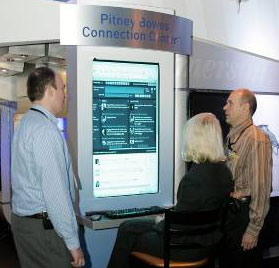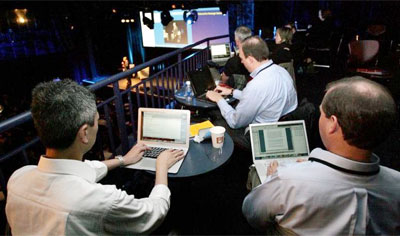Social Media for Event Activation

WIF 2009 Location in NYC
The more I think about the positive impact social media outreach can have on your business, the more ideas come to my head for new and creative ways to reach out and engage with your customers, prospects, future employees and others interested in your brand. For some of you these tactics will not be new, but many B2B marketers who are still afraid to take the plunge into social media will find these ideas new and refreshing.
And believe me, once you take the first step, write your first blog post, record your first podcast or attract new followers on Twitter, it gets progressively easier to introduce these ideas to your colleagues from marketing, PR, product development or customer care and see entire teams embracing the concept, brainstorming to fine tune it and finally executing it while measuring business results. Nirvana? No, a new business reality! Let me give you an example.
A few weeks back Pitney Bowes participated in the 2009 World Innovation Forum (WIF) in NYC. This is a thought leadership event that focuses on bringing world-class innovators and problem-solvers for two days of workshops and idea generation with regards to innovation in the workplace. This was Pitney Bowes’s second year participating and sponsoring this event, but, unlike last year, this year we went beyond setting up a booth and hanging up banners. It was the Innovation Forum after all and we were looking for innovative approaches to attention marketing, event activation and reaching out beyond the auditorium to capture the interest of the ever growing “virtual” event attendees. And social media delivered results for us.
THE OBJECTIVES
The objectives of our event sponsorship did not change only because we were using social media channels to achieve them. We still focused on increasing brand awareness of PB’s expanding capabilities and gaining consideration among new audiences.
THE STRATEGY and TACTICS

PB twitterer and WIF participants looking at TweetDeck screen.
The strategy did change between 2008 and 2009. In addition to setting up a booth featuring posters of Pitney Bowes new advertising campaign we placed heavy emphasis on social media channels to
- Engage and enable real-time interaction with both the audience gathered in the auditorium as well as many others who joined virtually by following tweeter feeds and reading blog posts that were created live during the event. Pitney Bowes had a dedicated Twitter handle @Pbconnect and dedicated twitterers @ColetteCotte and @BernieGracy who live tweeted from the event. We also used the Connection blog with Howard Wright (@wright1) a designated blogger who posted several blog posts throughout the event . They were all engaged in answering questions, commented on ideas of other participants and provided links to both PB- and non-PB generated online content. Above all, these social media outreach folks were there to make critical connections with other thought leaders providing brand exposure in places traditional marketing seldom reaches.
- Make it easy and convenient for others including key social media influencers (bloggers, twitterers, podcasters, etc.) to participate in social media content creation right at the event. To achieve that Pitney Bowes sponsored a Bloggers Hub, an area reserved for bloggers and other social media influencers that was set up to be accessible and comfortable for them to create content in real time and it gave Pitney Bowes though leaders a chance to interact with these influencers while representing the Pitney Bowes brand.
- Employ crowd sourcing via online polling to ask questions and compile answers to most burning business questions participants want to find answers to. This was achieved through online polls event attendees as well as virtual attendees were encouraged to participate in and comment on results.
RESULTS

PB blogger hub
If you are looking for the number of leads we gathered from this event, well… you won’t find it. The World Innovation Forum was not the type of event to promote Pitney Bowes product-specific offerings. What we were focusing on instead was measuring the word of mouth impact of our activities and determining the impact through connections and relationships that were established during the event.
Among the key performance indicators to measure brand awareness were
- Number of WIF specific tweets that included our brand, number of tweeterers re-tweeting PB content (which is a sought-after indication of value among Twitter community), number of new followers to our branded Twitter handles.
- Traffic to Pitney Bowes Connection Center – our thought leadership portal
- Engagement with the Connection Center blog including blog traffic, new visitors, # of comments, # of trackbacks (references to the blog created by other bloggers)
- Amount of external content (blogs, podcasts, media mentions) generated during the event that mentioned Pitney Bowes and our participation in the event.
- Number of poll participants.
KPIs focused on creating connections and building relationships were much harder to measure primarily because these are qualitative in nature and their impact will be determined overtime.
LESSONS LEARNED
- Don’t let fear prevent you from using social media for your event activation. Educate yourself and your bosses on what you are trying to do and how your activities will positively impact your event’s KPIs.
- If you are not very familiar with social media surround yourself with those who are. These might be your interactive agency folks, your in-house web design/development group. You can also find help among your co-workers who are successful bloggers, have a podcasting show, or gathered a large and vibrant Twitter following outside of work.
- Don’t bite more than you can chew. You don’t have to utilize every social media channel for your event. Go for the ones that are up and running already and those you are familiar with. Carefully consider opening new channels since they require set-up and “care and feeding” before being a hundred percent ready to give proper exposure for your event.
BEFORE EVENT
- Give yourself plenty of time to figure out your strategies and tactics. How much times? It depends on your familiarity with the media, the state of your channel development and whether you are doing it yourself or will have a group of folks helping you. It’s safe to say though that, unless you have done it before, staring to think about social media for your event activation a couple of days before the event will not guarantee great results.
- Tightly integrate your social media activities with other traditional event marketing activities including direct mailings, email blasts, booth setup and messaging development.
- Work closely with event organizers starting with higher-ups to understand opportunities and explain what you are doing and ending with setup crew to make sure you have enough power outlets and reliable internet connection.
- Meet with all folks that will be involved with social media event activation ahead of time to explain your goals and answer any questions about their involvement. Explain what they can/cannot write, tweet, photograph or video-record in terms of legal and privacy constraints.
- Don’t assume that all of your designated social media outreach folks know the channels, tactics and best practices. Always provide a set of online resources to learn and be available for a quick tutoring session. Check to make sure everybody is comfortable with what you are asking them to do.
- Be mindful of social media program details including
-
- Finding out which twitter handle(s) and hash tags you will be using.
- Identifying which corporate blog or other online content publishing space you will be utilizing for event specific content publishing . Make sure that this medium will allow for two-way communication (e.g. blog comments).
- Finding existing online content you will be able to leverage and preparing new content to be pushed out during the event (tweets, blog posts, etc.)
- Making sure all your social media content creators and outreach generation folks have mobile and/or remote access to social media channels (Twitterberry for twitter access on Blackberries, Facebook app for iPhone, extra notebook w/ TweetDeck, etc.)
- Reach out to those responsible for other social media channels within your organization and ask how they could be utilized to help activate your event.
- Figure out what your social media KPIs are and how to measure them.
- Finish everything that could be done before the event to make sure you have time to account for all the activity during the event.
AT EVENT
- Make sure you have a person designated to monitor all social media channels at large (which includes those you are not participating in). This person can be your primary onsite content generator for the event, but it can also be a person back at the office if you are short on resources onsite. This person will be responsible for monitoring event hash tag, sending previously written tweets, answer questions and starting relationships.
- Don’t forget that text is the most basic way you can capture content. Don’t settle for that. Have a photographer and/or videographer present or have a flip camera and your mobile phone to capture content yourself. Remember that timely posting of event content online will set you apart from other content providers. So say hallo to TwitPic http://www.twitpic.com/ , 12seconds http://12seconds.tv/home and don’t be shy and attach picture or video directly to your tweet.
- Social media content is fast but it does not mean it should make for a constant stream of low quality content. Pay attention to tweet density to prevent spamming your followers. Make efforts to prevent duplicate messaging being sent to the same channel particularly if there are more than one content creator assigned to the same channel.
POST-EVENT
- Make sure you take advantage of all content you accumulated throughout the event. Make sure everything has been tagged properly to take advantage of SEO and that all your new online contacts have been thanked for their time and attention.
- Set up a de-brief meeting not too long after the event so that everybody still remembers the details and you can learn from everybody what worked and what did not. Don’t think your meeting participants will be eager to share in a public forum? Talk to them separately or (and this is the least preferred method) send a survey to all participants.
- Compile your measurements.
- Don’t be shy to tell what worked/did not work to all that are willing to listen. This is the part you need to play in evangelizing social media to those who are still hesitant in trying it.

WIF Blogger Hub participants
Now it’s your turn. Comment and let me know what worked/did not work for your social media event activation campaign.


Aneta – can you share any of the specific numbers and analysis from WIF09? It was a fantastic event and very successful (we hit Twitter trending twice). I was more of active micro-blogger (Twitter) than blogger going into the event (you’ve got 3 photos of me above – in the group shot, the blogger’s lounge and next to Colette at the Twitter kiosk), but after getting some great exposure at the show and inspiration from the other bloggers, I’ve been blogging more. The social media exposure shined a positive light on everyone involved – great job for Pitney Bowes to be so innovative!
I’m also 1000% in agreement with you about getting more multi-media into social media.